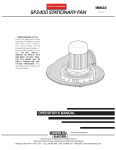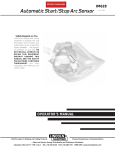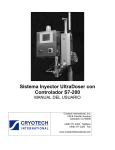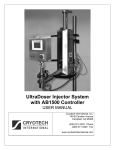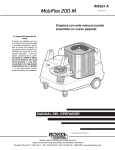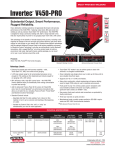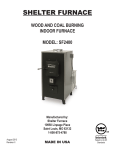Download Life is good 55LM671S Flat Panel Television User Manual
Transcript
RETURN TO MAIN MENU IM623-A LFA 3.1 & 4.1 Fume Extraction Arms May, 2001 Safety Depends on You Lincoln arc welding and cutting equipment is designed and built with safety in mind. However, your overall safety can be increased by proper installation ... and thoughtful operation on your part. DO NOT INSTALL, OPERATE OR REPAIR THIS EQUIPMENT WITHOUT READING THIS MANUAL AND THE SAFETY PRECAUTIONS CONTAINED THROUGHOUT. And, most importantly, think before you act and be careful. E OPERATOR’S MANUAL • World's Leader in Welding and Cutting Products • • Sales and Service through Subsidiaries and Distributors Worldwide • Cleveland, Ohio 44117-1199 U.S.A. TEL: 216.481.8100 FAX: 216.486.1751 WEB SITE: www.lincolnelectric.com i i SAFETY WARNING CALIFORNIA PROPOSITION 65 WARNINGS Diesel engine exhaust and some of its constituents are known to the State of California to cause cancer, birth defects, and other reproductive harm. The Above For Diesel Engines The engine exhaust from this product contains chemicals known to the State of California to cause cancer, birth defects, or other reproductive harm. The Above For Gasoline Engines ARC WELDING CAN BE HAZARDOUS. PROTECT YOURSELF AND OTHERS FROM POSSIBLE SERIOUS INJURY OR DEATH. KEEP CHILDREN AWAY. PACEMAKER WEARERS SHOULD CONSULT WITH THEIR DOCTOR BEFORE OPERATING. Read and understand the following safety highlights. For additional safety information, it is strongly recommended that you purchase a copy of “Safety in Welding & Cutting - ANSI Standard Z49.1” from the American Welding Society, P.O. Box 351040, Miami, Florida 33135 or CSA Standard W117.2-1974. A Free copy of “Arc Welding Safety” booklet E205 is available from the Lincoln Electric Company, 22801 St. Clair Avenue, Cleveland, Ohio 44117-1199. BE SURE THAT ALL INSTALLATION, OPERATION, MAINTENANCE AND REPAIR PROCEDURES ARE PERFORMED ONLY BY QUALIFIED INDIVIDUALS. FOR ENGINE powered equipment. 1.h. To avoid scalding, do not remove the radiator pressure cap when the engine is hot. 1.a. Turn the engine off before troubleshooting and maintenance work unless the maintenance work requires it to be running. ____________________________________________________ 1.b. Operate engines in open, well-ventilated areas or vent the engine exhaust fumes outdoors. ____________________________________________________ 1.c. Do not add the fuel near an open flame welding arc or when the engine is running. Stop the engine and allow it to cool before refueling to prevent spilled fuel from vaporizing on contact with hot engine parts and igniting. Do not spill fuel when filling tank. If fuel is spilled, wipe it up and do not start engine until fumes have been eliminated. ____________________________________________________ 1.d. Keep all equipment safety guards, covers and devices in position and in good repair.Keep hands, hair, clothing and tools away from V-belts, gears, fans and all other moving parts when starting, operating or repairing equipment. ____________________________________________________ 1.e. In some cases it may be necessary to remove safety guards to perform required maintenance. Remove guards only when necessary and replace them when the maintenance requiring their removal is complete. Always use the greatest care when working near moving parts. ___________________________________________________ 1.f. Do not put your hands near the engine fan. Do not attempt to override the governor or idler by pushing on the throttle control rods while the engine is running. ELECTRIC AND MAGNETIC FIELDS may be dangerous 2.a. Electric current flowing through any conductor causes localized Electric and Magnetic Fields (EMF). Welding current creates EMF fields around welding cables and welding machines 2.b. EMF fields may interfere with some pacemakers, and welders having a pacemaker should consult their physician before welding. 2.c. Exposure to EMF fields in welding may have other health effects which are now not known. 2.d. All welders should use the following procedures in order to minimize exposure to EMF fields from the welding circuit: 2.d.1. Route the electrode and work cables together - Secure them with tape when possible. 2.d.2. Never coil the electrode lead around your body. 2.d.3. Do not place your body between the electrode and work cables. If the electrode cable is on your right side, the work cable should also be on your right side. 2.d.4. Connect the work cable to the workpiece as close as possible to the area being welded. ___________________________________________________ 1.g. To prevent accidentally starting gasoline engines while turning the engine or welding generator during maintenance work, disconnect the spark plug wires, distributor cap or magneto wire as appropriate. 2.d.5. Do not work next to welding power source. Mar ‘95 ii ii SAFETY ARC RAYS can burn. ELECTRIC SHOCK can kill. 3.a. The electrode and work (or ground) circuits are electrically “hot” when the welder is on. Do not touch these “hot” parts with your bare skin or wet clothing. Wear dry, hole-free gloves to insulate hands. 3.b. Insulate yourself from work and ground using dry insulation. Make certain the insulation is large enough to cover your full area of physical contact with work and ground. In addition to the normal safety precautions, if welding must be performed under electrically hazardous conditions (in damp locations or while wearing wet clothing; on metal structures such as floors, gratings or scaffolds; when in cramped positions such as sitting, kneeling or lying, if there is a high risk of unavoidable or accidental contact with the workpiece or ground) use the following equipment: • Semiautomatic DC Constant Voltage (Wire) Welder. • DC Manual (Stick) Welder. • AC Welder with Reduced Voltage Control. 3.c. In semiautomatic or automatic wire welding, the electrode, electrode reel, welding head, nozzle or semiautomatic welding gun are also electrically “hot”. 3.d. Always be sure the work cable makes a good electrical connection with the metal being welded. The connection should be as close as possible to the area being welded. 3.e. Ground the work or metal to be welded to a good electrical (earth) ground. 3.f. Maintain the electrode holder, work clamp, welding cable and welding machine in good, safe operating condition. Replace damaged insulation. 3.g. Never dip the electrode in water for cooling. 3.h. Never simultaneously touch electrically “hot” parts of electrode holders connected to two welders because voltage between the two can be the total of the open circuit voltage of both welders. 3.i. When working above floor level, use a safety belt to protect yourself from a fall should you get a shock. 3.j. Also see Items 6.c. and 8. 4.a. Use a shield with the proper filter and cover plates to protect your eyes from sparks and the rays of the arc when welding or observing open arc welding. Headshield and filter lens should conform to ANSI Z87. I standards. 4.b. Use suitable clothing made from durable flame-resistant material to protect your skin and that of your helpers from the arc rays. 4.c. Protect other nearby personnel with suitable, non-flammable screening and/or warn them not to watch the arc nor expose themselves to the arc rays or to hot spatter or metal. FUMES AND GASES can be dangerous. 5.a. Welding may produce fumes and gases hazardous to health. Avoid breathing these fumes and gases.When welding, keep your head out of the fume. Use enough ventilation and/or exhaust at the arc to keep fumes and gases away from the breathing zone. When welding with electrodes which require special ventilation such as stainless or hard facing (see instructions on container or MSDS) or on lead or cadmium plated steel and other metals or coatings which produce highly toxic fumes, keep exposure as low as possible and below Threshold Limit Values (TLV) using local exhaust or mechanical ventilation. In confined spaces or in some circumstances, outdoors, a respirator may be required. Additional precautions are also required when welding on galvanized steel. 5.b. Do not weld in locations near chlorinated hydrocarbon vapors coming from degreasing, cleaning or spraying operations. The heat and rays of the arc can react with solvent vapors to form phosgene, a highly toxic gas, and other irritating products. 5.c. Shielding gases used for arc welding can displace air and cause injury or death. Always use enough ventilation, especially in confined areas, to insure breathing air is safe. 5.d. Read and understand the manufacturer’s instructions for this equipment and the consumables to be used, including the material safety data sheet (MSDS) and follow your employer’s safety practices. MSDS forms are available from your welding distributor or from the manufacturer. 5.e. Also see item 1.b. Mar ‘95 iii iii SAFETY WELDING SPARKS can cause fire or explosion. 6.a. Remove fire hazards from the welding area. If this is not possible, cover them to prevent the welding sparks from starting a fire. Remember that welding sparks and hot materials from welding can easily go through small cracks and openings to adjacent areas. Avoid welding near hydraulic lines. Have a fire extinguisher readily available. 6.b. Where compressed gases are to be used at the job site, special precautions should be used to prevent hazardous situations. Refer to “Safety in Welding and Cutting” (ANSI Standard Z49.1) and the operating information for the equipment being used. 6.c. When not welding, make certain no part of the electrode circuit is touching the work or ground. Accidental contact can cause overheating and create a fire hazard. 6.d. Do not heat, cut or weld tanks, drums or containers until the proper steps have been taken to insure that such procedures will not cause flammable or toxic vapors from substances inside. They can cause an explosion even though they have been “cleaned”. For information, purchase “Recommended Safe Practices for the Preparation for Welding and Cutting of Containers and Piping That Have Held Hazardous Substances”, AWS F4.1 from the American Welding Society (see address above). 6.e. Vent hollow castings or containers before heating, cutting or welding. They may explode. 6.f. Sparks and spatter are thrown from the welding arc. Wear oil free protective garments such as leather gloves, heavy shirt, cuffless trousers, high shoes and a cap over your hair. Wear ear plugs when welding out of position or in confined places. Always wear safety glasses with side shields when in a welding area. 6.g. Connect the work cable to the work as close to the welding area as practical. Work cables connected to the building framework or other locations away from the welding area increase the possibility of the welding current passing through lifting chains, crane cables or other alternate circuits. This can create fire hazards or overheat lifting chains or cables until they fail. 6.h. Also see item 1.c. CYLINDER may explode if damaged. 7.a. Use only compressed gas cylinders containing the correct shielding gas for the process used and properly operating regulators designed for the gas and pressure used. All hoses, fittings, etc. should be suitable for the application and maintained in good condition. 7.b. Always keep cylinders in an upright position securely chained to an undercarriage or fixed support. 7.c. Cylinders should be located: • Away from areas where they may be struck or subjected to physical damage. • A safe distance from arc welding or cutting operations and any other source of heat, sparks, or flame. 7.d. Never allow the electrode, electrode holder or any other electrically “hot” parts to touch a cylinder. 7.e. Keep your head and face away from the cylinder valve outlet when opening the cylinder valve. 7.f. Valve protection caps should always be in place and hand tight except when the cylinder is in use or connected for use. 7.g. Read and follow the instructions on compressed gas cylinders, associated equipment, and CGA publication P-l, “Precautions for Safe Handling of Compressed Gases in Cylinders,” available from the Compressed Gas Association 1235 Jefferson Davis Highway, Arlington, VA 22202. FOR ELECTRICALLY powered equipment. 8.a. Turn off input power using the disconnect switch at the fuse box before working on the equipment. 8.b. Install equipment in accordance with the U.S. National Electrical Code, all local codes and the manufacturer’s recommendations. 8.c. Ground the equipment in accordance with the U.S. National Electrical Code and the manufacturer’s recommendations. Mar ‘95 iv iv SAFETY PRÉCAUTIONS DE SÛRETÉ Pour votre propre protection lire et observer toutes les instructions et les précautions de sûreté specifiques qui parraissent dans ce manuel aussi bien que les précautions de sûreté générales suivantes: Sûreté Pour Soudage A L’Arc 1. Protegez-vous contre la secousse électrique: a. Les circuits à l’électrode et à la piéce sont sous tension quand la machine à souder est en marche. Eviter toujours tout contact entre les parties sous tension et la peau nue ou les vétements mouillés. Porter des gants secs et sans trous pour isoler les mains. b. Faire trés attention de bien s’isoler de la masse quand on soude dans des endroits humides, ou sur un plancher metallique ou des grilles metalliques, principalement dans les positions assis ou couché pour lesquelles une grande partie du corps peut être en contact avec la masse. c. Maintenir le porte-électrode, la pince de masse, le câble de soudage et la machine à souder en bon et sûr état defonctionnement. d.Ne jamais plonger le porte-électrode dans l’eau pour le refroidir. e. Ne jamais toucher simultanément les parties sous tension des porte-électrodes connectés à deux machines à souder parce que la tension entre les deux pinces peut être le total de la tension à vide des deux machines. f. Si on utilise la machine à souder comme une source de courant pour soudage semi-automatique, ces precautions pour le porte-électrode s’applicuent aussi au pistolet de soudage. 2. Dans le cas de travail au dessus du niveau du sol, se protéger contre les chutes dans le cas ou on recoit un choc. Ne jamais enrouler le câble-électrode autour de n’importe quelle partie du corps. 3. Un coup d’arc peut être plus sévère qu’un coup de soliel, donc: a. Utiliser un bon masque avec un verre filtrant approprié ainsi qu’un verre blanc afin de se protéger les yeux du rayonnement de l’arc et des projections quand on soude ou quand on regarde l’arc. b. Porter des vêtements convenables afin de protéger la peau de soudeur et des aides contre le rayonnement de l‘arc. c. Protéger l’autre personnel travaillant à proximité au soudage à l’aide d’écrans appropriés et non-inflammables. 4. Des gouttes de laitier en fusion sont émises de l’arc de soudage. Se protéger avec des vêtements de protection libres de l’huile, tels que les gants en cuir, chemise épaisse, pantalons sans revers, et chaussures montantes. 5. Toujours porter des lunettes de sécurité dans la zone de soudage. Utiliser des lunettes avec écrans lateraux dans les zones où l’on pique le laitier. 6. Eloigner les matériaux inflammables ou les recouvrir afin de prévenir tout risque d’incendie dû aux étincelles. 7. Quand on ne soude pas, poser la pince à une endroit isolé de la masse. Un court-circuit accidental peut provoquer un échauffement et un risque d’incendie. 8. S’assurer que la masse est connectée le plus prés possible de la zone de travail qu’il est pratique de le faire. Si on place la masse sur la charpente de la construction ou d’autres endroits éloignés de la zone de travail, on augmente le risque de voir passer le courant de soudage par les chaines de levage, câbles de grue, ou autres circuits. Cela peut provoquer des risques d’incendie ou d’echauffement des chaines et des câbles jusqu’à ce qu’ils se rompent. 9. Assurer une ventilation suffisante dans la zone de soudage. Ceci est particuliérement important pour le soudage de tôles galvanisées plombées, ou cadmiées ou tout autre métal qui produit des fumeés toxiques. 10. Ne pas souder en présence de vapeurs de chlore provenant d’opérations de dégraissage, nettoyage ou pistolage. La chaleur ou les rayons de l’arc peuvent réagir avec les vapeurs du solvant pour produire du phosgéne (gas fortement toxique) ou autres produits irritants. 11. Pour obtenir de plus amples renseignements sur la sûreté, voir le code “Code for safety in welding and cutting” CSA Standard W 117.2-1974. PRÉCAUTIONS DE SÛRETÉ POUR LES MACHINES À SOUDER À TRANSFORMATEUR ET À REDRESSEUR 1. Relier à la terre le chassis du poste conformement au code de l’électricité et aux recommendations du fabricant. Le dispositif de montage ou la piece à souder doit être branché à une bonne mise à la terre. 2. Autant que possible, I’installation et l’entretien du poste seront effectués par un électricien qualifié. 3. Avant de faires des travaux à l’interieur de poste, la debrancher à l’interrupteur à la boite de fusibles. 4. Garder tous les couvercles et dispositifs de sûreté à leur place. Mar. ‘93 v v for selecting a QUALITY product by Lincoln Electric. We want you to take pride in operating this Lincoln Electric Company product ••• as much pride as we have in bringing this product to you! Thank You Please Examine Carton and Equipment For Damage Immediately When this equipment is shipped, title passes to the purchaser upon receipt by the carrier. Consequently, Claims for material damaged in shipment must be made by the purchaser against the transportation company at the time the shipment is received. Please record your equipment identification information below for future reference. This information can be found on your machine nameplate. Model Name & Number _____________________________________ Code & Serial Number _____________________________________ Date of Purchase _____________________________________ Whenever you request replacement parts for or information on this equipment always supply the information you have recorded above. Read this Operators Manual completely before attempting to use this equipment. Save this manual and keep it handy for quick reference. Pay particular attention to the safety instructions we have provided for your protection. The level of seriousness to be applied to each is explained below: The identification plate specifies: A. Serial number B. Product name TYPE SER. NR. W. WARNING This statement appears where the information must be followed exactly to avoid serious personal injury or loss of life. CAUTION This statement appears where the information must be followed to avoid minor personal injury or damage to this equipment. TABLE OF CONTENTS Safety Page .......................................................................................................................................i-iv Installation.......................................................................................................................Section A Technical Specifications .......................................................................................................A-1 Safety Precautions ...............................................................................................................A-2 General Description..............................................................................................................A-2 Installing the LFA 3.1 or 4.1 Arm on a Wall Mounting Bracket .............................................A-3 Operation.........................................................................................................................Section B Safety Instructions ................................................................................................................B-1 Operating Instructions ..........................................................................................................B-1 Maintenance ....................................................................................................................Section C Routine Maintenance ...........................................................................................................C-1 Trouble Shooting ............................................................................................................Section D Trouble Shooting Chart ........................................................................................................D-1 Parts List......................................................................................................................P320 Series vi A-1 A-1 INSTALLATION Technical Specifications- LFA 3.1 & 4.1 Fume Extraction Arms GENERAL Sales Specification K1655-1 K1655-2 Description LFA 3.1, 10 ft. Extraction Arm LFA 4.1, 13 ft. Extraction Arm Arm Length (including hood) 9.85 ft. (3 m) 13.13 ft. (4 m) Nominal Diameter 8.0 in. (203 mm) 350 CFM (600 m3/h) - 940 CFM (1,600 m3/h) Recommended Capacity Weight 33 lbs. (15 kg) 37 lbs. (17 kg) 16 ft. AMBIENT CONDITIONS o o 13 ft. Min. Temperature 41 F (5 C) Max. Temperature 113 F (45 C) o o 10 ft. Max. Rel. Humidity 80% 6 ft. PRESSURE DROP - SF2400 Fan and LFA 3.1/4.1 Arms Vacuum (Inches WG) 3 ft. 0 ft. 13 ft. SF 2400 10 ft. 6 ft. 3 ft. 0 ft. 20 ft. 6 16 ft. 4 13 ft. LTA 3.1/4.1 10 ft. 2 6 ft. 3 ft. 0 0 250 500 750 1000 0 ft. Air Flow (CFM) 0 ft. 3 ft. 6 ft. 10 ft. 13 ft. NOTE: Technical Specifications are subject to change without prior notice. Specifications and guarantees are valid only when specified spare parts and filters are used. LFA 3.1 & 4.1 FUME EXTRACTION ARMS A-2 A-2 INSTALLATION Read this entire installation section before you start installation. SAFETY PRECAUTIONS Do not attempt to use this equipment until you have thoroughly read all installation, operating and maintenance information supplied with your equipment. They include important safety precautions and detailed operating and maintenance instructions. WARNING ELECTRIC SHOCK can kill. • Do not touch electrically live parts such as internal wiring. • Turn the input power off at the fuse box before working on this equipment. • Have a qualified person install and service this equipment. ------------------------------------------------------------------------ If installing the arm on a Mobiflex 200-M, refer to the Mobiflex 200-M manual for installation information. If installing the arm on a Mobiflex 400-MS, refer to the Mobiflex 400-MS manual for installation information. If installing the arm with an SF2400 Fan, refer to the SF2400 Fan manual for installation information This manual covers installation of a: K1655-1 LFA 3.1, 10 ft. Arm or K1655-2 LFA 4.1, 13 ft. Arm on a K1657-1 Wall Mounting Bracket If installing the arm on an Extension Crane without a K1656-1 SF2400 Fan, refer to the Extension Crane manual for installation information. WARNING MOVING PARTS can injure. • Do not operate with covers open or filter removed. • Keep away from moving parts. -----------------------------------------------------------------------Only qualified personnel should install, use or service this equipment. GENERAL DESCRIPTION Lincoln’s LFA extraction arms are spring-balanced for easy positioning. They are intended for use with a low-vacuum, high-volume extraction fan. The LFA arms are commonly installed on a Mobiflex 200-M mobile base unit with filter or with an SF2400 WallMounted Extraction Fan, with or without a Statiflex 200-M Wall-Mounted Filter Unit. Extension Cranes are available in 7 ft. and 14 ft. lengths, with an optional Feeder Hanging Rail. Lamp Kits available for both the Mobiflex and Wall-Mounted Systems provide hoodmounted switches for the light and connected fan system. An Automatic Start/Stop Arc Sensor can be installed with either lamp kit to automatically start the connected extraction system (Mobiflex 200-M or SF2400 Fan) when the sensor detects a welding arc. Installation procedures for the K1655-1 and K1655-2, LFA 3.1 and 4.1 Extraction Arms have been combined; the difference between the arms is the length of the arm sections, which does not affect installation procedures. The installer is responsible for following local safety codes and regulations. -----------------------------------------------------------------------Before drilling, verify locations of existing gas, water, or electrical conduits. -----------------------------------------------------------------------K1655-1 LFA 3.1 or K1655-2 LFA 4.1 Arm Includes: • Assembled arm pieces • Flexible hose, (2) 8” Rubber seals for hood hinge • (2) 8” Rubber seals for base hinge • Hood assembly • (2) Bolts, M8x1.25, 45mm long (about 1.75”) • (2) Nuts, M8 self-locking • Hose running guard • Clamping pin for red plastic ring • Metal rotating hinge • Red plastic ring K1657-1 Wall Mounting Bracket Includes: • (2) Bracket pieces • Hanging Adapter • Spring Bracket • Flexible Hose, (2) 8” Rubber bands for arm base • (2) Bolts, M8x1.25, 45mm long (about 1.75”) • (4) Bolts, M8x1.25, 75mm long (about 3.00”) • (6) Nuts, M8 self-locking • (6) Washers, M8 LFA 3.1 & 4.1 FUME EXTRACTION ARMS A-3 A-3 INSTALLATION INSTALLING THE LFA 3.1 OR 4.1 ARM ON A WALL MOUNTING BRACKET 8.3" (210 mm) WARNING Only qualified personnel should install, use or service this equipment. ------------------------------------------------------------------------ Leave the tape and plastic packaging on the extraction arm sections until the arm is completely installed (including mounting the hood). The arm is spring-balanced to compensate for the weight of the hood and will spring out quickly if it is not mounted securely, with the hood in place. -----------------------------------------------------------------------MOUNTING THE WALL-MOUNTING BRACKET 7.0 ft. CAUTION 9" (230 mm) Fig. 2 Figure 2 shows drilling dimensions. Standard mounting height is approximately 7 ft. from the floor to the lower mounting holes. Figure 1 shows suggested mounting methods for installation on various wall types. Mounting on a steel I-beam using four 3/8 in. (M10) threaded rods and two box-profile stabilizers (1x1x0.1 in., 30x30x3 mm) Fig. 1 3/8" Mounting on a thin wall (recommended minimum wall thickness 5 in. (100 mm), using four 3/8 in. (M10) threaded rods. 3/8" 3/8" Mounting on a thick wall using four 3/8 in. (M10) cotter bolts. 3/8" LFA 3.1 & 4.1 FUME EXTRACTION ARMS A-4 A-4 INSTALLATION INSTALLING THE LFA 3.1 OR 4.1 ARM ON A WALL MOUNTING BRACKET (continued) MOUNTING THE LFA 3.1 OR 4.1 ARM TO THE WALL-MOUNTING BRACKET Rotate the hinge rod (Fig. 4, Item D) so the stop pin (Fig. 4, Item B) is in the front. Mount the hanging adapter (Fig. 5, Item D) to the hinge rod using (2) 1.75” bolts with washers and nuts. Mount the spring bracket (Fig. 5, Item F) into the two holes as shown. Position one 8” rubber band (Fig. 5, Item A) and the flexible hose supplied with the mounting bracket (Fig. 5, Item E) on the red plastic ring of the rotating hinge. A The rotating hinge of the arm comes in three pieces: Metal rotating hinge, red plastic ring, and clamping pin. Refer to Figure 3. Mount the red plastic ring to the metal rotating hinge by fitting the clamping pin through the hole in the rotating rod, and snapping it into place on the U-shaped indents on the red plastic ring. The lip of the ring should fit securely against the top edge of the rotating flange, yet rotate with the rod. The assembly should look like Part C in Figure 4. B C D E F 2 Fig. 5 1 Put another rubber band on the top of the arm. Use (2) 1.75” bolts with nuts to mount the arm (Fig. 6, Item B) to the hanging adapter (Fig. 6, Item A), using both mounting holes as indicated. 3 A Fig. 3 Position the rotating hinge on the wall mounting bracket (See Fig. 4) so that the cable hole (Fig. 4, Item A) is on the wall side. Use the four 3” bolts with washers and nuts to secure the rotating hinge to the wall mounting bracket. C A B Fig. 6 D Fig. 4 E LFA 3.1 & 4.1 FUME EXTRACTION ARMS B A-5 A-5 INSTALLATION INSTALLING THE LFA 3.1 OR 4.1 ARM ON A WALL MOUNTING BRACKET If using a Lincoln SF2400 Stationary Fan: MOUNTING THE SF2400 FAN TO THE WALL MOUNTING BRACKET (continued) MOUNTING THE LFA 3.1 OR 4.1 ARM TO THE WALL-MOUNTING BRACKET (continued) Use the (2) 0.75” bolts and the (2) 2.5” bolts with washers supplied with the fan to mount the fan (Fig. 9, Item B) to the rotating hinge (Fig. 9, Item C) as shown. Tighten all mounting bolts firmly to make the seal at the inlet of the fan. Position one 8” rubber band (Fig. 7, Item B) and the flexible hose supplied with the arm (Fig. 7, Item C) on the hood end of the arm (Fig. 7, Item A). Put the last rubber band on the hood connection. Mount the hood as shown in Figure 7. A A B C B C Fig. 9 D Fig. 7 Snap the hose running guard into place atop the middle hinge so the “nose” end faces the base of the arm as shown in Figure 8. A Starter/Overload switch or Lamp Kit must be installed to provide power to the fan. Refer to the SF2400 Stationary Fan manual for instructions on installation of a complete wall-mounted system. Fig. 8 Remove the plastic and tape packaging from the arm sections. Adjust the friction of the arm and hood movement as described in the maintenance section of this manual. When set, seal all hose connections with the rubber seals. LFA 3.1 & 4.1 FUME EXTRACTION ARMS B-1 OPERATION B-1 Read and understand this entire section before operating your LFA 3.1 or 4.1 Extraction Arm. Only qualified personnel should operate this equipment. SAFETY INSTRUCTIONS ADDITIONAL SAFETY PRECAUTIONS Do not attempt to use this equipment until you have thoroughly read all operating and maintenance manuals supplied with your equipment and any related welding machine it will be used with. They include important safety precautions, operating and maintenance instructions and parts lists. Always operate the fan with the arm installed and all covers in place as these provide maximum protection from moving parts and insure proper vacuum operation and cooling air flow. WARNING ELECTRIC SHOCK can kill. •Do not touch electrically live parts such as output terminals or internal wiring. •Insulate yourself from the work and ground. •Always wear dry insulating gloves. -----------------------------------------------------------------------WELDING SPARKS can cause fire or explosion. •Keep flammable material away. OPERATING INSTRUCTIONS Turn on the connected extraction system. For details, refer to the Operating Instructions in the Mobiflex 200-M, Mobiflex 400-MS, or SF2400 Stationary Fan manual, as appropriate. For optimum fume capture, position the hood within 10-15 inches (250-400 mm) of the arc. Use the rotary valve on the base of the hood to adjust the airflow to an apropriate level, if desired. If using a Lamp Kit: The switch on the hood with a lamp symbol operates the work lamp in the hood. If using an Auto Start/Stop Arc Sensor: The arc sensor will automatically switch the fan on when it senses an arc. Standard run-out time is approximately 20 sec. The work lamp operates independently of this sensor. •Do not weld upon containers which have held combustibles. -----------------------------------------------------------------------ARC RAYS can burn. •Wear eye, ear and body protection. ------------------------------------------------------------------------ FUMES AND GASES can be dangerous. • Although the removal of the particulate matter from welding smoke may reduce the ventilation requirement, concentrations of the clear exhausted fumes and gases may still be hazardous to health. Avoid breathing concentrations of these fumes and gases. Use adequate ventilation when welding. See ANSI Z49.1, "Safety in Welding and Cutting", published by the American Welding Society. -----------------------------------------------------------------------LFA 3.1 & 4.1 FUME EXTRACTION ARMS C-1 C-1 MAINTENANCE ROUTINE MAINTENANCE Every 3 months, check the integrity of the outside of the extraction arm and clean it with a non-agressive detergent. B Every 12 months: • Check the flexible hoses and rubber seals for cracks or damage; replace if necessary. • Check the inside of the extraction arm and clean it thoroughly. • Check and lubricate the hinge points with lubricating oil. (See Fig. 10 C) • Check and lubricate the steel cable near the balance wheel with lubricating grease. (See Fig. 10 B) • Check the steel cables for wear. • Check and adjust the friction setting of the hood, middle, and base hinges. (See Fig. 10 A, Fig. 11) • Check the balance construction of the extraction arm. (See Fig. 10 A) • Check the operation of the airflow throttle valve. B Fig. 11 Fig. 10 A B Adjust friction A with a wrench C C C A C Lubricate with grease B C(2x) C(2x) 360° A Lubricate with oil C A F B LFA 3.1 & 4.1 FUME EXTRACTION ARMS D-1 D-1 TROUBLESHOOTING Observe all Safety Guidelines detailed throughout this manual SYMPTOM PROBLEM SOLUTION Extraction arm creaks or squeaks. Insufficient lubrication. Lubricate hinge points as described in the Maintenance Section. Poor suction. Leakage. Check hose connections and integrity Fan outlet blocked. Remove obstructions from fan outlet. Air path in arm blocked. Remove obstructions from arm. Filter blocked (if used). Check maintenance indicator and replace filter if necessary. Spark arrester blocked (if used). Clean the spark arrester. Blower fan blocked. Clean excess fume or spatter from fan. Fan seal damaged. Check or replace sealing material of fan. For troubleshooting Fan or Filter problems, refer to the corresponding manual. CAUTION If for any reason you do not understand the test procedures or are unable to perform the tests/repairs safely, contact your Local Lincoln Authorized Field Service Facility for technical troubleshooting assistance before you proceed. LFA 3.1 & 4.1 FUME EXTRACTION ARMS NOTES X-TRACTOR 1GC Now Available...12th Edition The Procedure Handbook of Arc Welding New Lessons in Arc Welding This printing will go fast so don’t delay. Place your order now using the coupon below. Lessons, simply written, cover manipulatory techniques; machine and electrode characteristics; related subjects, such as distortion; and supplemental information on arc welding applications, speeds and costs. Practice materials, exercises, questions and answers are suggested for each lesson. The hardbound book contains over 750 pages of welding information, techniques and procedures. Much of this material has never been included in any other book. 528 pages, well illustrated, 6” x 9” size, bound in simulated, gold embossed leather. $5.00 postage paid U.S.A. Mainland With over 500,000 copies of previous editions published since 1933, the Procedure Handbook is considered by many to be the “Bible” of the arc welding industry. A must for all welders, supervisors, engineers and designers. Many welding instructors will want to use the book as a reference for all students by taking advantage of the low quantity discount prices which include shipping by 4th class parcel post. $15.00 postage paid U.S.A. Mainland Need Welding Training? How To Read Shop Drawings The book contains the latest information and application data on the American Welding Society Standard Welding Symbols. Detailed discussion tells how engineers and draftsmen use the “short-cut” language of symbols to pass on assembly and welding information to shop personnel. Practical exercises and examples develop the reader’s ability to visualize mechanically drawn objects as they will appear in their assembled form. The Lincoln Electric Company operates the oldest and most respected Arc Welding School in the United States at its corporate headquarters in Cleveland, Ohio. Over 100,000 students have graduated. Tuition is low and the training is “hands on” For details write: Lincoln Welding School 22801 St. Clair Ave. Cleveland, Ohio 44117-1199. and ask for bulletin ED-80 or call 216-383-2259 and ask for the Welding School Registrar. 187 pages with more than 100 illustrations. Size 8-1/2” x 11” Durable, cloth-covered board binding. $4.50 postage paid U.S.A. Mainland Lincoln Welding School BASIC COURSE 5 weeks of fundamentals $700.00 There is a 10% discount on all orders of $50.00 or more for shipment at one time to one location. Orders of $50 or less before discount or orders outside of North America must be prepaid with charge, check or money order in U.S. Funds Only. Prices include shipment by 4 th Class Book Rate for U.S.A. Mainland Only. Please allow up to 4 weeks for delivery. UPS Shipping for North America Only. All prepaid orders that request UPS shipment please add: $5.00 For order value up to $49.99 $10.00 For order value between $50.00 & $99.99 $15.00 For order value between $100.00 & $149.00 For North America invoiced orders over $50.00 & credit card orders, if UPS is requested, it will be invoiced or charged to you at cost. Outside U.S.A. Mainland order must be prepaid in U.S. Funds. Please add $2.00 per book for surface mail or $15.00 per book for air parcel post shipment. METHOD OF PAYMENT: (Sorry, No C.O.D. Orders) Name: _______________________________________________ CHECK ONE: Please Invoice (only if order is over $50.00) Check or Money Order Enclosed, U.S. Funds only Credit Card MasterCard VISA Address: _______________________________________________ _______________________________________________ Telephone: _______________________________________________ ® ® Account No. |_|_|_|_|_|_|_|_|_|_|_|_|_|_|_|_|_|_|_|_|_| AMERICAN EXPRESS MasterCard Exp Date |_|_| |_|_| Month Year Signature as it appears on Charge Card: ______________________ AMERICAN EXPRESS USE THIS FORM TO ORDER: BOOKS OR FREE INFORMATIVE CATALOGS Lincoln Welding School (ED-80) Seminar Information (ED-45) Educational Video Information (ED-93) James F. Lincoln Arc Welding Foundation Book Information (JFLF-515) Order from: BOOK DIVISION, The Lincoln Electric Company, 22801 St. Clair Avenue, Cleveland, Ohio 44117-1199 Telephone: 216-383-2211 or, for fastest service, FAX this completed form to: 216-361-5901. Titles: Price New Lessons in Arc Welding $5.00 Procedure Handbook “Twelfth Edition” $15.00 How to Read Shop Drawings $4.50 Incentive Management $5.00 A New Approach to Industrial Economics $5.00 The American Century of John C. Lincoln $5.00 Welding Preheat Calculator $3.00 Pipe Welding Charts $4.50 Code L PH H IM NA AC WC-8 ED-89 Quantity SUB TOTAL Additional Shipping Costs if any TOTAL COST Cost ● Do not touch electrically live parts or WARNING Spanish AVISO DE PRECAUCION French ATTENTION German WARNUNG Portuguese ATENÇÃO ● Keep flammable materials away. ● Wear eye, ear and body protection. ● Mantenga el material combustible ● Protéjase los ojos, los oídos y el electrode with skin or wet clothing. ● Insulate yourself from work and ground. ● No toque las partes o los electrodos bajo carga con la piel o ropa mojada. ● Aislese del trabajo y de la tierra. ● Ne laissez ni la peau ni des vête- ments mouillés entrer en contact avec des pièces sous tension. ● Isolez-vous du travail et de la terre. ● Berühren Sie keine stromführenden Teile oder Elektroden mit Ihrem Körper oder feuchter Kleidung! ● Isolieren Sie sich von den Elektroden und dem Erdboden! ● Não toque partes elétricas e elec- trodos com a pele ou roupa molhada. ● Isole-se da peça e terra. fuera del área de trabajo. ● Gardez à l’écart de tout matériel inflammable. ● Entfernen Sie brennbarres Material! cuerpo. ● Protégez vos yeux, vos oreilles et votre corps. ● Tragen Sie Augen-, Ohren- und Kör- perschutz! ● Mantenha inflamáveis bem guarda- dos. ● Use proteção para a vista, ouvido e corpo. Japanese Chinese Korean Arabic READ AND UNDERSTAND THE MANUFACTURER’S INSTRUCTION FOR THIS EQUIPMENT AND THE CONSUMABLES TO BE USED AND FOLLOW YOUR EMPLOYER’S SAFETY PRACTICES. SE RECOMIENDA LEER Y ENTENDER LAS INSTRUCCIONES DEL FABRICANTE PARA EL USO DE ESTE EQUIPO Y LOS CONSUMIBLES QUE VA A UTILIZAR, SIGA LAS MEDIDAS DE SEGURIDAD DE SU SUPERVISOR. LISEZ ET COMPRENEZ LES INSTRUCTIONS DU FABRICANT EN CE QUI REGARDE CET EQUIPMENT ET LES PRODUITS A ETRE EMPLOYES ET SUIVEZ LES PROCEDURES DE SECURITE DE VOTRE EMPLOYEUR. LESEN SIE UND BEFOLGEN SIE DIE BETRIEBSANLEITUNG DER ANLAGE UND DEN ELEKTRODENEINSATZ DES HERSTELLERS. DIE UNFALLVERHÜTUNGSVORSCHRIFTEN DES ARBEITGEBERS SIND EBENFALLS ZU BEACHTEN. ● Keep your head out of fumes. ● Use ventilation or exhaust to ● Turn power off before servicing. ● Do not operate with panel open or guards off. remove fumes from breathing zone. ● Los humos fuera de la zona de res- piración. ● Mantenga la cabeza fuera de los humos. Utilice ventilación o aspiración para gases. ● Gardez la tête à l’écart des fumées. ● Utilisez un ventilateur ou un aspira- ● Desconectar el cable de ali- mentación de poder de la máquina antes de iniciar cualquier servicio. ● Débranchez le courant avant l’entre- tien. teur pour ôter les fumées des zones de travail. ● Vermeiden Sie das Einatmen von Schweibrauch! ● Sorgen Sie für gute Be- und Entlüftung des Arbeitsplatzes! ● Mantenha seu rosto da fumaça. ● Use ventilação e exhaustão para remover fumo da zona respiratória. ● Strom vor Wartungsarbeiten ● No operar con panel abierto o guardas quitadas. ● N’opérez pas avec les panneaux ouverts ou avec les dispositifs de protection enlevés. ● Anlage nie ohne Schutzgehäuse abschalten! (Netzstrom völlig öffnen; Maschine anhalten!) oder Innenschutzverkleidung in Betrieb setzen! ● Não opere com as tampas removidas. ● Desligue a corrente antes de fazer ● Mantenha-se afastado das partes serviço. ● Não toque as partes elétricas nuas. ● Não opere com os paineis abertos moventes. WARNING Spanish AVISO DE PRECAUCION French ATTENTION German WARNUNG Portuguese ATENÇÃO ou guardas removidas. Japanese Chinese Korean Arabic LEIA E COMPREENDA AS INSTRUÇÕES DO FABRICANTE PARA ESTE EQUIPAMENTO E AS PARTES DE USO, E SIGA AS PRÁTICAS DE SEGURANÇA DO EMPREGADOR. • World's Leader in Welding and Cutting Products • • Sales and Service through Subsidiaries and Distributors Worldwide • Cleveland, Ohio 44117-1199 U.S.A. TEL: 216.481.8100 FAX: 216.486.1751 WEB SITE: www.lincolnelectric.com




















